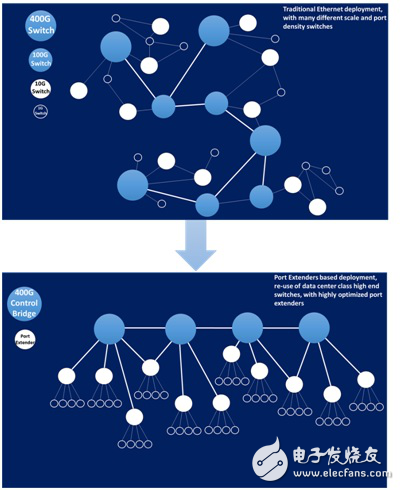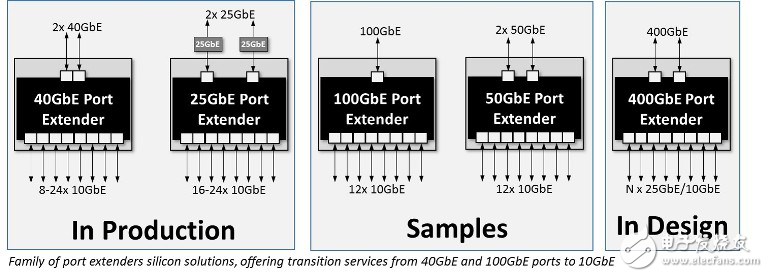Author: Michael Zimmerman, Marvell connection, server, Vice President, Infrastructure Business Unit (CSIBU) and Managing Director
Over the past three decades, Ethernet has evolved into a unified communications infrastructure for all industries. More than three million Ethernet ports are deployed every day, covering all speeds from FE to 100GbE. Enterprises and carriers typically use a combination of box-type switching devices and stacked and high-density chassis switches to address the evolving Ethernet. However, in the past few years, the development of Ethernet is constantly changing. As data center Ethernet deployments and innovations are moving at the fastest pace, the Ethernet switch fabric for data centers dominates, making the enterprise and carrier markets a necessity. This new paradigm shift makes the choice of architecture for the data center in the entire Ethernet market critical and influential. However, the way data centers are deployed is different.

The data center's Ethernet port deployment tends to be the same. Whether it's 10GbE, 25GbE, or 50GbE, the same Ethernet port speed is deployed on each server through a rack-mount (ToR) switch and then aggregated into multiple CLOS layers. . The ultimate goal is to deploy as many Ethernet ports as possible on the Ethernet switch at the highest commercial speeds, making it the most economical and energy efficient. The terminal connected to the ToR switch is the server NIC (Network Interface Card), which is generally the highest speed available on the market (currently 10/25 GbE, is moving toward 25/50 GbE). Today, 128 interfaces for 25GbE switches are being deployed and will reach and surpass 64x 100GbE in the next few years. However, while data centers are moving toward higher port densities, higher port speeds, and homogeneous deployments, lower speeds still have a broad market, such as 10GbE continues to be used and still economically viable. Data center innovations drive higher density and higher port speeds, but many segments still require solutions with lower port speeds and different densities. How to solve this problem?
Narrowing the gapFortunately, the technology to connect lower speed ports to higher density switches has been around for several years. The IEEE standard-edited 802.1br port expander standard acts as a required protocol, allowing fans to be fanned out of ports with higher original speeds. In essence, a high-end, high-port density switch can fan out hundreds or even thousands of lower-speed ports. High-density switches are the bridge of control, while devices that fan out lower-speed ports are port expanders.
Why use a port extender?In addition to repackaging the data center switch as a control bridge, there are some unique advantages to using a port extender:
1. Compared to any other solution that serves Ethernet ports, port expanders require very little cost, power, and board space.
2. The port expander has very little software or even software. This simplified operational deployment reduces management entities and is limited to high-end control bridges.
3. The port expander can communicate with any high-end switch via the standard protocol 802.1br. Other options include Marvell DSA, or a programmable header.
4. The port expander works well with any conversion service: 100GbE to 10GbE ports, 400GbE to 25GbE ports, and more.
5. The port expander can operate at any downstream speed: 1GbE, 2.5GbE, 10GbE, 25GbE, etc.
6. The port expander can be oversubscribed or non-oversubscribed, which means that the upstream and downstream bandwidth ratio can be designed from 1:1 to 1:4 (depending on the application). . This in itself can reduce cost and power consumption through 4x specifications.

Marvell port extender
Marvell has introduced several dedicated port expander products that fan out 1GbE and 10GbE ports from 40GbE and 100GbE higher speed ports. Along with the chip solution, software reference code is also available and can be easily integrated into a control bridge. Marvell conducted interoperability testing with various control bridge switches, including the market's leading switches. This benchmark design brings twice the cost reduction and 2x power savings. The SDK, datasheets, and design packages are now ready. The Marvell IEEE 802.1br port expander is currently shipping to the market.
We cover many types of Connectors for industrial, electrical and automotive, such as IP68 and waterproof connectors, OBD diagnostic connectors, also the standard or custom-designed power connectors for MINI FIT, MICRO FIT, MATE-N-LOCK.
Connectors System,Board System Connector,Efi System Injector Connector,Efi System Car Connector
ETOP WIREHARNESS LIMITED , https://www.oemwireharness.com